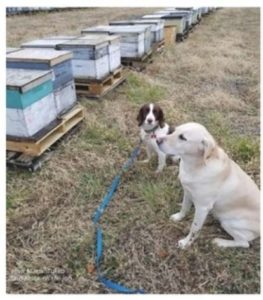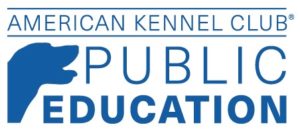
Photo from Digital Family Dog Magazine July-August 2019
Learning Objectives
Students will answer questions by citing evidence from the text. Students will defend an opinion using details from the text.
Grade Levels
Grades 5-6
Common Core Standards
CCSS.ELA-LITERACY.RI.6.1
Cite textual evidence to support analysis of what the text says explicitly as well as inferences drawn from the text.
CCSS.ELA-LITERACY.RI.6.2
Determine a central idea of a text and how it is conveyed through particular details; provide a summary of the text distinct from personal opinions or judgments.
CCSS.ELA-LITERACY.RI.6.3
Analyze in detail how a key individual, event, or idea is introduced, illustrated, and elaborated in a text (e.g., through examples or anecdotes).
Materials Needed
Student copies of article or web-enabled devices to read it digitally
Canine Apiary Inspector Question Sheet
Lesson
Introduction
- Ask students to briefly glance through the article and make observations about the text features, such as photos, captions, title and subheading.
- What do students expect to learn about by reading this article?
Explicit Instruction/Teacher Modeling
- Model how to annotate the text, using the first paragraph.
- If students each have a paper copy, you can model writing and drawing on the text. If students are using a digital copy, model using a journal or notebook paper for the annotation. For the purposes of this lesson, we will assume each student has a printed copy of the article.
- Draw a stick figure in the margin near paragraph 1 to represent yourself and write a personal connection you have to the story. This could be a thought bubble saying any connection that comes to mind, like: “I’m scared of bees.” “Bees are important for pollinating flowers.” “I have a dog like the one in the pictures.” Connecting with the text helps increase comprehension and gives students a purpose for reading.
- Underline or circle any unfamiliar words. Possible vocabulary could be scent training, apiary in the first paragraph. Discuss with students how to find out what the words mean. Some teachers encourage the use of dictionary; others prefer that students try using context clues and ask each other or the teacher for a definition before going to the dictionary.
- Make a note of questions you have. In the first paragraph you might note, “I wonder why Cybil Preston had a good feeling about Tukka even though he failed K-9 training.” Or “Why does a strong desire for work make him good for working with bees?”
- Look for author’s purpose or message. You may want students to highlight or put a box around passages that indicate the author’s message or purpose. In the first paragraph, point out that the author is trying to show us that Tukka is a good candidate for being an apiary inspector even though he failed at being a police dog.
Independent Working Time
- Students read the rest of the article and annotate the text, following your model. You can have students complete this task working individually, or with partners or small groups.
- A fun way to change it up from an independent activity is to have students roll dice to choose which question to answer from the sheet and then present and defend their response to the group.
Review and Closing
- Discuss answers to the questions on the sheet and remind students to cite the text when telling why they gave the answer they chose.
Extension
- Draw a line on the board and label one end “Agree” and the other end “Disagree.” Ask students to write their name on a sticky note or on the board and place it where their opinion lies on the continuum. Some questions to debate include:
-Should we train dogs to sniff bacteria in beehives?
-Are Canine Apiary Inspectors a cost-effective way to protect bee colonies?
-Would you want to work with dogs and/or bees like this?
Resources
Correia, Manuel and Bleicher, Robert. (Spring 2008). Making Connections to Teach Reflection. Michigan Journal of Community Service Learning. Pages 41-49. Retrieved from https://files.eric.ed.gov/fulltext/EJ831372.pdf
Jodi Helmer (July-August 2019). Family Dog. Scent Dog helps take care of bees. Retrieved From http://viewer.zmags.com/publication/bc61b83c?utm_source=Sailthru&utm_medium=email&utm_campaign=20190709_FamilyDog_JulyAugust2019&utm_term=Family_Dog_Send_List#/bc61b83c/24


